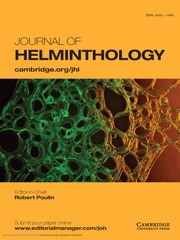No CrossRef data available.
Article contents
Phenol oxidase activity of a monogenean, Paramazocraes thrissocles
Published online by Cambridge University Press: 05 June 2009
Abstract
The phenol oxidase of a monogenean, Paramazocraes thrissocles, oxidizes phenolic amines more effectively than other phenols studied. Based on the substrate specificity, the probable substrate for eggshell formation has been suggested. The enzyme shows the pH optimum of 7–2. At 40°C it shows maximum activity. Proenzyme is activated by metal ions and detergents. Copper chelating compounds strongly inhibit the enzyme.
- Type
- Research Article
- Information
- Copyright
- Copyright © Cambridge University Press 1986
References
REFERENCES
Anderson, S. O. (1980) Cuticular sclerotization. In: Cuticle Techniques in Arthropods (Editor Miller, T. A.), pp. 185–215. Springer-Verlag: New York, Heidelberg and Berlin.CrossRefGoogle Scholar
Brunet, P. C. J. (1980) The metabolism of aromatic amino acids concerned in the cross linking of insect cuticle. Insect Biochemistry, 10, 467–500.CrossRefGoogle Scholar
Karlson, P. & Liebau, H. (1961) Zum tyrosinstoffwechsel der Insecten V. Reindarstellung, Kristalisation und substratspezifitat der O-Diphenoloxydas aus Calliphora erythrocephala. Hoppe-Seyler's Zeitschrift für Physiologische Chemie, 326, 135–143.CrossRefGoogle Scholar
Lowry, O. H., Rosebrough, N. J., Farr, A. L. & Randall, R.J. (1951) Protein measurements with Folin phenol reagent. Journal of Biological Chemistry, 240, 1489–1491.Google Scholar
Ma, L. (1963) Trace elements and polyphenoloxidase in Clonorchis sinensis. Journal of Parasitology, 49, 197–203.CrossRefGoogle ScholarPubMed
Mansour, T. E. (1958) Effect of serotonin on phenoloxidase from the liver fluke Fasciola hepatica and from other sources. Biochemica et Biophysica Acta, 30, 492–500.CrossRefGoogle ScholarPubMed
Nellaiappan, K. (1977) Studies on physiology and biology of hemiurid trematodes of marine fishes with special reference to ‘egg’ formation. Ph.D. Thesis, University of Madras.Google Scholar
Nellaiappan, K. & Ramalingam, K. (1980) Specificity of the enzyme phenoloxidase and possible metabolic pathway of sclerotization in Paraplerurus sauridae. Journal of Parasitology, 66, 217–219.CrossRefGoogle ScholarPubMed
Nellaiappan, K., Thangaraj, T. & Ramalingam, K. (1982) Phenoloxidase activity and its role in cuticular sclerotization in a mole crab Emerita asiatica. Journal of Experimental Marine Biology and Ecology, 61, 75–83.CrossRefGoogle Scholar
Ramalingam, K. (1971) Studies on vitelline cells of Monogenea: II. Characterization of odiphenoloxidase. Experimental Parasitology, 30, 407–417.CrossRefGoogle Scholar
Seed, J. L., Kilts, C. O. & Bennett, J.L. (1980) Schistosoma mansoni: Tyrosine a putative in vivo substrate of phenoloxidase. Experimental Parasitology, 50, 33–44.CrossRefGoogle Scholar
Smyth, J. D. (1976) Introduction to animal parasitology. Hodder and Stoughton: London, Auckland and Toronto.Google Scholar
Sokal, R. R. & Rohlf, F.J. (1969) Biometry-the principles and practice of statistics in biological research. W. H. Freeman and Company: San Francisco, USA.Google Scholar
Thangaraj, T., Nellaiappan, K. & Ramalingam, K. (1982) Comparative studies on cuticular and blood phenoloxidases of a shore crab Ocypod platytarsis. Archives Internationales de Physiologie et de Biochemie, 90, 63–68.CrossRefGoogle ScholarPubMed
Waite, J. H. & Wilbur, K.M. (1976) Phenoloxidase in the periostracum of the marine bivalve Modiolus demissus. Journal of Experimental Zoology, 195, 359–368.CrossRefGoogle Scholar
Yamazaki, H. I. (1969) The cuticular phenoloxidase in Drosophila virilis. Journal of Insect Physiology, 15, 2203–2211.CrossRefGoogle Scholar


